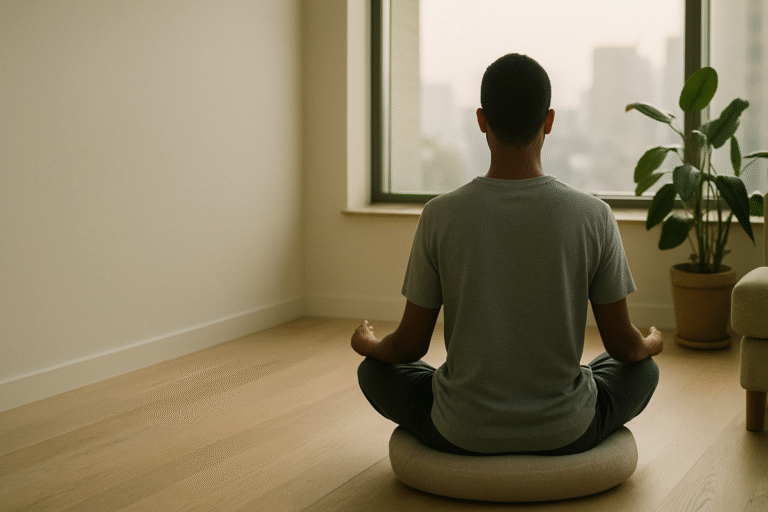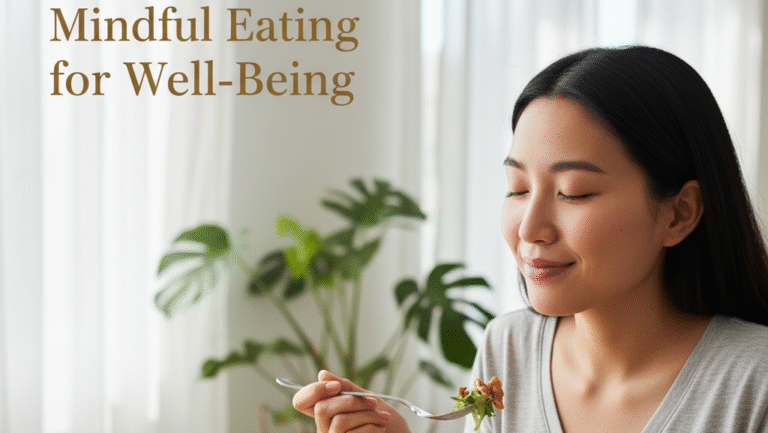Mindfulness for Beginners: The Complete Starter Kit

Introduction to Mindfulness for Beginners
Mindfulness isn’t about “switching off your thoughts.” It’s a gentle training of attention and attitude so you can meet each moment with clarity and kindness. Think: noticing, not judging; responding, not reacting.
What Is Mindfulness? (A touch deeper)
Mindfulness is paying attention, on purpose, to the present moment without judgment. Two core skills sit underneath:
- Attention training: Learning to place and keep your attention (e.g., on the breath).
- Attitude training: Meeting your experience with curiosity, patience, and warmth.
You’ll see two broad styles of practice:
- Focused Attention (FA): Rest attention on an anchor (breath, sounds, body). When the mind wanders, notice and return.
- Open Monitoring (OM): Widen awareness to include thoughts, feelings, sensations, and sounds, observing them come and go.
Why Practice? (Real-world payoffs)
- Stress & anxiety: Less rumination, more steadiness.
- Focus & productivity: Notice distractions sooner; return faster.
- Emotional regulation: The pause between trigger and response widens.
- Self-awareness & growth: Spot patterns; choose better habits.
- Wellbeing & connection: More kindness toward yourself and others.
- Pain & discomfort: Shift your relationship to difficult sensations.
Core Practices
1) Body Scan (5–15 minutes)
- Set-up: Lie down or sit supported; soften jaw/shoulders.
- Method: Move attention slowly from toes to head. Note sensations (pressure, warmth, tingling, neutral). If there’s numbness or nothing, that’s a valid observation.
- When wandering happens: Label it lightly (“thinking,” “planning”), and return to the body part you’re on.
- Why it helps: Reconnects mind and body; lowers baseline tension.
2) Mindful Breathing (2–10 minutes)
- Anchor options: Nostrils (cool in/warm out), belly rise/fall, or the whole breathing body.
- Optional counting: Inhale “1,” exhale “2,” up to 10, then restart.
- Adjustments: If breath focus is agitating, use sounds or hands as your anchor.
- Why it helps: Trains steadiness and present-moment awareness.
3) Mindful Eating (1–3 minutes)
- One bite practice: Look → smell → touch → taste → chew → swallow.
- Tip: Try your first two bites this way at one meal daily.
- Why it helps: Retrains automaticity; boosts satisfaction and pace.
4) Mindful Walking (5–15 minutes)
- Indoor or outdoor: A hallway or a short path is perfect.
- Focus: Heel touches → weight shifts → toe lifts. Add sounds/sights as a secondary layer.
- Why it helps: Great when you’re restless, sleepy, or short on time.
5) Everyday Mindfulness (micro-moments)
- Habit pairings: After the kettle clicks, before you open email; while brushing teeth; at red lights.
- Recipe: Three mindful breaths + one sensation check (“Where do I feel this in the body?”).
Two Evidence-Informed Frameworks You’ll Love
The STOP Technique (60–90 seconds)
- S – Stop: Freeze the autopilot.
- T – Take a breath: One slow breath in, one out.
- O – Observe: Body sensations, emotions, thoughts, surroundings.
- P – Proceed: Choose the next wise action (sometimes it’s doing nothing).
RAIN (3–10 minutes)
- R – Recognise what’s here (name it: “tightness,” “worry”).
- A – Allow it to be present (no fixing right now).
- I – Investigate kindly (Where is it in the body? What does it need?).
- N – Nurture with care (hand on heart, kind phrase: “This is hard; I’m here.”).
14-Day Mindfulness Kick-Start (progressive + practical)
Week 1: Build the habit (tiny, consistent)
- Day 1: 2 min mindful breathing + log one sentence.
- Day 2: 5 min body scan.
- Day 3: 5 min mindful walk.
- Day 4: Mindful eating (2 bites) + 3 min breathing.
- Day 5: STOP once mid-day + 5 min breathing.
- Day 6: 7 min body scan.
- Day 7: 8–10 min mix (breath 5, body 3, sounds 2).
Week 2: Widen the lens (skills + real life)
- Day 8: 6 min open monitoring (notice thoughts/sensations/sounds).
- Day 9: RAIN (7 min) with a mild stressor.
- Day 10: 10 min mindful walk outdoors; finish with 3 gratitude notes.
- Day 11: “Inbox pause”: 1 STOP before opening email + 5 min breathing.
- Day 12: Mindful eating for first 3 bites at a meal + 5 min breath.
- Day 13: 12 min body scan (slower pacing).
- Day 14: Choose your favourite practice; 12–15 min total. Reflect: “What changed in 2 weeks?”
Tiny tracking template (one-line journal):
Date — Minutes — Practice — Noticed — Mood before/after (0–10)
Scripts You Can Record (verbatim-friendly)
3-Minute Centering (studio-clean)
Settle into a comfortable posture. Let the shoulders drop and the jaw soften. Feel the weight of your body and the contact points beneath you.
Bring your attention to the breath, just as it is. Notice one inhale, one exhale. If the mind wanders, acknowledge it kindly and return to the breath.
Widen awareness to the whole body: areas of ease or tightness, temperature, contact, and posture.
Choose one anchor, breath, hands, or sounds and rest attention there for a few breaths. When you’re ready, open your eyes and continue your day.
10-Minute Body + Breath (steady focus)
Minutes 0–2: Arrive (posture, soften, three slower breaths).
2–8: Body scan toes → head in gentle segments; note and move on.
If thoughts carry you off, label “thinking” and return to the body part you’re on.
8–10: Rest attention with the breath at the belly or nostrils. End with one intention: “May I meet the next hour with clarity and kindness.”
Micro-Practices You Can Do Anywhere (30–90 seconds)
- 3×3 Breath: Three slow breaths, three times today (morning, midday, evening).
- Name it to tame it: “Worry is here,” “Tightness in chest.” Label softly; breathe once.
- Hand on heart: One breath with a kind phrase: “This is tough; I’ve got you.”
- Sensory reset: Name 5 things you see, 4 feel, 3 hear, 2 smell, 1 taste.
- Doorway cue: Every time you pass a doorway, relax your shoulders and exhale fully.
Everyday Contexts (how to apply)
- Work: One STOP before big emails or meetings; 60-second breath at calendar transitions; 5 mindful sips of tea/coffee mid-afternoon.
- Parenting & caregiving: Three breaths before responding; narrate feelings with kids (“I feel rushed; I’m taking one breath.”).
- Sleep wind-down: Body scan in bed; if agitated, switch to counting exhales from 27 down.
- Pain or discomfort: Shorten the focus area (e.g., just the boundaries of the ache). Alternate 10 seconds on pain, 10 seconds on neutral sensations (hands/feet).
Troubleshooting by Scenario
- “My mind won’t stop.” Minds think. The “rep” is noticing and returning. Count every return as a success.
- Restless or fidgety: Try mindful walking; shorten sits; keep eyes slightly open.
- Sleepy: Practice earlier; sit upright; switch to standing or walking.
- Anxious on the breath: Use sounds or hands as an anchor; practice RAIN; keep sessions brief.
- Too busy: Use micro-practices at natural pauses (kettle, lift, login screens).
- All-or-nothing mindset: Minimum viable dose is one minute. Consistency beats intensity.
Safety, Scope, and When to Get Support
Mindfulness is a skill, not a medical treatment. It can surface strong emotions, especially with trauma histories. If practice spikes distress, consider guidance from a qualified teacher or mental-health professional. It’s okay to switch anchors, keep eyes open, or pause entirely.
Quick-Glance Checklist
- Choose a tiny daily slot (2–5 min).
- Pick an anchor (breath, body, sounds, hands).
- Posture: Upright, relaxed, jaw/shoulders soft.
- Loop: Notice → name → return.
- Finish with one kind phrase (“Doing my best is enough.”).
- Track: One line in your log.
- Repeat tomorrow.
FAQs
How long until I notice benefits?
Some calm can show up immediately; meaningful change tends to come from a few minutes most days across a few weeks.
Do I need silence?
Helpful, not required. If it’s noisy, use sounds as your anchor.
What if I get bored?
Boredom is a great teacher. Notice the texture of boredom (heavy? itchy? restless?) and keep practising for another minute.
Is mindfulness the same as meditation?
Meditation is a formal practice that builds the quality of mindfulness. You can also practice mindfulness informally during daily tasks.
Can I lie down?
Yes – especially for body scans or pain. If you get sleepy, try sitting or walking.
What if practice makes me more anxious?
Switch anchors (sounds/hands), shorten sessions, keep eyes open, or try RAIN. If distress persists, seek guided support.
Should I use an app?
If it helps you be consistent, yes. Insight Timer (free), Headspace, Calm, and Ten Percent Happier are solid options.
Is breathing the only way?
No. Body sensations, sounds, touch points, or visual anchors all work.
Can I count it if I only did one minute?
Absolutely. One sincere minute daily beats occasional long sessions.
What’s the difference between noticing and judging?
Noticing describes (“tightness in jaw”). Judging evaluates (“this is bad”). Stick with describing.
How do I keep from falling asleep?
Practice earlier in the day, sit tall with eyes slightly open, or walk.
How do I bring this to arguments/conflict?
Use STOP before replying; feel your feet; name your emotion silently; speak one sentence slower than usual.
Habit-Building Tips (that actually work)
- Anchor to a routine: After brushing teeth → 2 minutes breathing.
- Make it visible: Cushion or chair set up; timer ready.
- Track streaks: One-line log; reward with a small treat at 7 and 14 days.
- Start comically small: 60 seconds is enough to build identity: “I’m someone who practices.”




